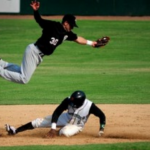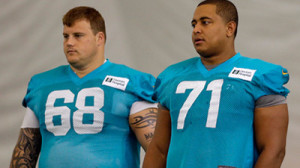Reaction to Richie Incognito and What You Can Learn
The recent scandal involving the oft troubled Richie Incognito and Jonathan Martin has brought the unfortunate reality of hazing in the NFL and other sports to the forefront of the casual sports fan’s mind. I am the first to admit that I was not there and have probably heard no more about it than any of you. I have heard the accusations against Incognito as well as the voice mail he left Martin during training camp. I am fully aware that this type of thing probably happens in most NFL locker rooms and most of the time, the individual on the receiving end does not react in the way Jonathan Martin did… but that doesn’t make it ok. More surprising than the fact that hazing goes on in the NFL is the reaction to it around the league.
Check Out Our Bronze Library Here
Most players and coaches (with the exception of Hunter Hillenmeyer and Marc Trestman) I have heard talk about this situation admit that Incognito may have crossed the line, but then go on to say that someone who is an adult and plays in the NFL should be “mentally tougher” than Martin and should just learn to deal with it. Another common defense of the situation has been “how can a 6’5 325 pound man be bullied?” The answer to that question is simple, bullying and hazing do not have to be a physical act, the abuse is often mental. Incognito used his status on the team and in the league as a veteran to intimidate and abuse Martin, leaving Martin few choices but to either physically confront him, report the abuse to his coach and GM, or leave the team. When the GM told his agent to “punch Incognito in the face,” Martin made the correct decision by removing himself from the situation.
In fact, the bullying and hazing that Martin endured could have been a direct result of his coach telling Incognito to “toughen” him up. There is no doubt that a career in the NFL is not for the physically or mentally squeamish. There are 11 giant men ON THE OTHER SIDE OF THE BALL who are trying to hit you as hard as they can on every play of the game. The key phrase there is “ON THE OTHER SIDE OF THE BALL.” It is tough enough to play against the players on the other team, let alone having to constantly battle players on your own team. This activity does not contribute to a winning culture. Winners stick together and have each other’s back. When he is constantly fighting off attacks from those on his side, it is no wonder Martin needed to get away from that team.
Check Out Our Silver Coaching Certification
One of the more impressive figures in the saga (even though he has not been directly involved) is Bears head coach Marc Trestman who very clearly stated to his team on day one of training camp that those types of behaviors will not be tolerated. In an article by 670 The Score’s Adam Hoge (http://chicago.cbslocal.com/2013/11/06/hoge-trestman-stopped-bullying-before-it-ever-started/) Marc Trestman states:
“We’re not talking about taking someone’s helmet, we’re talking about other things. The words you use, the way you act, the things you say, affect people from all different backgrounds and places. We’ve got to understand that the beauty of this game is it draws people from everywhere, from different realities and different perceptions, but that can all be neutralized through respect and using the proper language and proper words in the right place and the right time.”
Coach Trestman really seems to understand that even though hazing of rookies may be “the way it has always been done,” it is not necessarily the right way to do things and certainly doesn’t contribute in any way (and in fact probably detracts from) winning football games, or winning games in any sport. In amateur athletics, it serves only as a means of praying on the weak and feeding the egos of insecure players. What Trestman understand is that if you are playing tug of war, the whole team needs to pull in the same direction for maximum results. Hazing, bullying and abuse are the equivalent of players pulling in the opposite direction.
I have never been in an NFL locker room, but I know that hazing serves no purpose, specifically it does not:
1.) Toughen players up mentally and physically
2.) Bring teams closer together
3.) Make people earn their position
4.) Create a sense of unity
5.) Contribute to a winning culture
What hazing really does:
1.) Creates a culture of secrecy between players and coaches that extends to all aspects of the team
2.) Creates a sense of entitlement with certain players on the team
3.) Creates a culture of resentment between teammates and the coaching staff
4.) Makes it more likely that players who awere re hazed will haze in the future (and probably worse)
5.) Divides teams into cliques
6.) Detracts from the sense of team
7.) Makes it difficult for players to work together on the field
8.) Makes players resent the team and not want to be part of it
As a coach, there is no possible way to monitor 100% of what is going on with your team. This task becomes especially difficult in 2013 with text messages, Facebook, Twitter, Snap Chat and probably 100 other social media sites that can be grossly abused while hiding behind a phone or computer. A coach CAN create an environment where players respect one another, work toward a common goal, and are not tempted to haze or bully by:
1.) Not allowing freshmen, underclassmen, or non-starters be responsible for carrying equipment. Put this in the hands of your seniors, captains, and starters. This guards against a sense of entitlement.
2.) Talk about hazing. Make it known what types of behavior are and are not acceptable on your team.
3.) Take all claims of bullying and hazing seriously. What may seem like a harmless joke to one individual may be hurtful to another.
4.) Stop problems before they start. The quickest way to encourage hazing is to let small little inappropriate activities go. They tend to build quickly and many times what is going on when you aren’t there is worse than what you hear or see.
5.) Supervise your team whenever possible. You cannot be with all members of the team at all times, but you can supervise while they are at a team function (practice, game or activity)
6.) Don’t assume you have good people on your team and it wouldn’t happen. Even good people get caught up in mob mentality and do things they would never do on their own.
Hazing has no place in any locker room and does not contribute to the well-being of the team or the players on the team. Coaching is more than simply teaching the game you love. It is ensuring the safety of the young athletes parents entrust to you, and building quality characters on and off the field. Kudos to Coach Trestman and his approach to stopping hazing in the NFL while still preparing his players to play a violent game. This approach can work in the NFL and will certainly work in the youth, high school, and college levels. But it starts with you, the coach.
More from my site
 CCA Podcast 240 – Maximizing the First 20 Minutes of Practice – Part 3
CCA Podcast 240 – Maximizing the First 20 Minutes of Practice – Part 3 CCA Podcast 219 – Elite Member’s Mini Clinic – Bunting, Conditioning After Shutdown & Breaking Balls
CCA Podcast 219 – Elite Member’s Mini Clinic – Bunting, Conditioning After Shutdown & Breaking Balls CCA Podcast Episode 013: How to steal bases with amazing efficiency
CCA Podcast Episode 013: How to steal bases with amazing efficiency CCA Podcast 204 – Dirt ball reads, base running efficiency, and taking over a program
CCA Podcast 204 – Dirt ball reads, base running efficiency, and taking over a program CCA Podcast 239 – Maximizing the First 20 Minutes of Practice – Part 2
CCA Podcast 239 – Maximizing the First 20 Minutes of Practice – Part 2 CCA Podcast 076 – Effective rundowns in 2 throws or less
CCA Podcast 076 – Effective rundowns in 2 throws or less
 Posted by Kyle Nelson
Posted by Kyle Nelson- Posted in Uncategorized
 Nov, 10, 2013
Nov, 10, 2013 2 Comments.
2 Comments.
Elite members login here
Check out what’s New/Hot!
Recognizing, Diagnosing, and Fixing Common Hitting Flaws eCourse The 3 metrics we tested on Blast motion sensors this year Sneak Peek Inside an Elite Q and A The batting practice continuum Elite Member’s area table of contents 50+ “Chaos” hitting drills
5 sample Chaos hitting drills FREE
Mental Skills and Culture Building The hitting pyramid Welcome Elite Member, Trey! Ideas for a pitcher first practice 12 week bat speed improvement plan Make plans this offseason to have your team playing their best baseball at the end of the year” Top 5 hitting drills to translate practice skill to game performanceHow we used Blast Motion sensors with a team in 2019
What to do if your hitters are overmatched Welcome Elite Member, Tommy! Setting your baserunners up for success Welcome Elite Member, Mike! A consulting call with Elite Member Matt FREE Web Clinic: Developing Athletic, Consistent, Extraordinary Infielders
 Coach Kyle Nelson
Coach Kyle Nelson
Kyle:
As a high school baseball coach that has been coaching for 20 years now, I can really appreciate this blog about the whole hazing/bullying incident with the Miami Dolphins. There really is no place for it anywhere let alone within your team especially when you are all trying to do something so positive. Unfortunately, all it takes is one incident to impact your entire season. A season that you, as a coach, have been preparing for since the day after your last season ended. I like that you say that as a coach we cannot monitor our players 100% of the time especially with all the social media that these kids are caught up in. Last year 2 days in to our spring season we had an incident between 3 boys on our team, who all were friends. Without getting into too much detail, 2 of the boys thought it would be funny to place the other young man (their friend) in a vicarious position and post a picture of it on one of the social media networks. All of this happened while some of the coaching staff was in the coaches office and others on the staff were suppervising the locker room. This incident took a matter of seconds and nothing was brought to our attention by any of the players. Not the ones involved and not the ones that witnessed the hazing incident. The biggest problem that I had with the entire incident is that I and the other coaches were questioned and sort of put on “trial” for something that we have very little control of. Teaching and coaching is my lively hood, it is my career and this act of immaturity and thoughtlessness could have easily ended that. I was extremely disappointed to know that all the boys, even the ones that were not directly involved did not have the mind and respect to come to the coaches and tell us what happened. In no way am I defending what happened. I was angered and appauled by it. But even though I will speak to my team this year about hazing and bulleying and treating eachother with respect and staying off of social media for the betterment of the team, it only takes one or two guys to not hear what I am saying and again jeopardize a coaches career and/or a teams success.
How does a coach reach everyone?
I am also a high school coach and I don’t believe we can reach everyone. Kids will always make bad decisions. I think the best you can do is create an environment of respect to try to eliminate those types of activities, and create an open environment so hopefully someone will come talk to you if it does. I’m not saying you didn’t do those things, just that even if you do those things, we are still dealing with 15-18 year old kids who are constantly tempted to do the wrong thing. Combine this with the ease of posting something online and it is impossible to stop once someone makes the decision to abuse it.
I think unless there is a gross misjudgment by administration, if you supervise properly, discuss hazing and appropriate social media use, create an environment of respect and openness, and react in a timely and appropriate manner if something is brought to your attention, you have really done all you can and there should be no fault placed on you. At some point, the people
It sounds like you have a good plan in place for this season. In the past I have looked up some local hazing incidents that involve high school and college athletes to show what hazing is (some kids don’t know what it looks like) and to show how it can negatively impact players, coaches, and teams. Good luck and feel free to bounce any ideas off me, or give me any that you find particularly effective kyle@cornerstonecoachingacademy.com.
Kyle Nelson
Owner and Founder
Cornerstone Coaching Academy